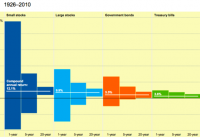Having written about VWELX, a reader asked my take on sister fund VWINX. The two are pretty much the reverse of each other. That, in the end, winds up being a risk issue for potential investors. A lot of investors look at bonds as a way to generate income. And that’s true. But in an asset allocation model, they are also a way to provide diversification and stability. In other words, a big part of owning bonds is safety. And that’s where a comparison of value-focused Vanguard Wellesley Income Fund (MUTF: VWINX ) and Vanguard Wellington Fund (MUTF: VWELX ) leads to some interesting findings. One down, now for number two I recently wrote an article about Vanguard Wellington . Within the comments, a reader asked if I would also take a look at sister fund Vanguard Wellesley. The comparison of the two is actually pretty interesting and highlights an important aspect of investing: risk. Wellington’s portfolio goal is to actively invest in stocks and bonds with a mix of roughly two-third stocks and one-third bonds. There’s a band around those percentages since it’s an actively managed fund, but it generally keeps pretty close to its goals. Sister fund Wellesley’s goal is the mirror image, one-third in stocks and two-thirds in bonds. And what that means for performance is very important. For example, as you might expect, Wellington outperforms bond-heavy Wellesley over the trailing one-, three-, five-, 10-, and 15-year periods through June on an annualized total return basis. That said, over the longer periods, the numbers start to get pretty close. There’s just 30 basis points or so separating the two funds over the 15-year period and around one percentage point over the trailing decade. But, the trend is intact, the fund with more stocks does, indeed, do better on an absolute basis. Interestingly, the income both funds generate is pretty close, too. Wellesley’s trailing 12-month yield is a touch under 3%. Wellington’s yield is roughly 2.5%. To be fair, a good portion of that has to do with the current low rate environment. In a different period, with higher interest rates, I would expect Wellesley’s yield advantage to be larger. But what about risk? But return and distributions aren’t the only factors to consider. Bonds are also about risk control. And on that score, these two funds have very different profiles. For example, over the trailing three years, Wellington’s standard deviation, a measure of volatility, is around 5.5. That’s a pretty low standard deviation. However, Wellesley’s number is an even lower 4. For most conservative investors, either of those two figures would be agreeable. Looking out over longer periods starts to show a bigger gap. For example, over the trailing 15-year period, Wellesley’s standard deviation is roughly 6 and Wellington’s is around 9.5. That’s a more meaningful difference. And remember that the two funds had very similar performance numbers over that span. Thus, over the trailing three years, Wellington’s Sharpe ratio of 2, a figure that measures the amount of return relative to the amount of risk taken, outdistances Wellesley’s 1.7. But over the trailing 15 years, those numbers flip, with Wellesley’s Sharpe ratio of 1 outdistancing Wellington’s 0.7 or so. Since performance over that longer term is so close, the big reason for the difference here is risk. Who’s right for what? At the end of the day, the two funds are both good options for conservative investors looking for a balanced fund. The biggest difference is really in the investor’s desire for safety. If the higher bond component in Wellesley will help you sleep better at night, then you should probably go with the more conservative of these two funds. If you don’t find solace in having more bonds in your portfolio, go with Wellington – noting that the choice is likely to lead to a slightly higher risk profile. That said, there’s a caveat. Interest rates are at historic lows. Bond prices and interest rates move in opposite directions. So when rates go down, bond prices go up. That’s been a tailwind for Wellesley for quite some time. If rates start to move higher quickly, however, that could turn into a headwind because as rates go up, bond prices go down. Wellesley’s higher debt component will mean rising rates are a bigger issue for the fund than for its sibling. However, both funds are run by the same management company and have been around a long time. They have dealt with shifting interest rates before. So this is something to keep in mind, but I wouldn’t let it deter me from purchasing either of these two well-run funds if my goal was to own them for a long time. Disclosure: I/we have no positions in any stocks mentioned, and no plans to initiate any positions within the next 72 hours. (More…) I wrote this article myself, and it expresses my own opinions. I am not receiving compensation for it (other than from Seeking Alpha). I have no business relationship with any company whose stock is mentioned in this article.
